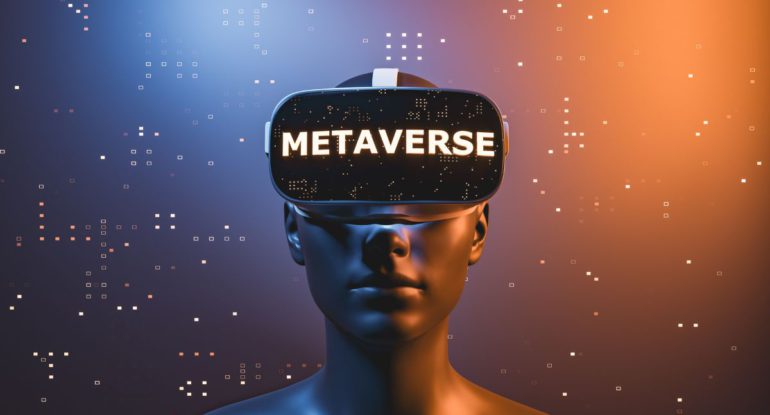Why Is Metaverse Development Severely Dependent On NFT Integration And Blockchain Technology?

The metaverse, a concept that was once confined to the realms of science fiction, has now become a tangible and rapidly evolving digital landscape. It’s a space where people can immerse themselves in a shared, digital reality, socialize, work, explore, and even create. While the metaverse’s potential is vast, its development is significantly dependent on two critical components: NFT (Non-Fungible Token) integration and blockchain technology.
In this article, we will delve into the reasons why metaverse development is intricately tied to NFT integration and blockchain technology. These two pillars underpin the creation of virtual universes and offer a glimpse into the transformative power of digital innovation.
How NFT Integration and Blockchain underpin the Metaverse development

1. True Ownership of Digital Assets:
In the metaverse, users can buy, sell, and trade digital assets, ranging from virtual real estate to digital art, clothing, and more. What makes this possible is the concept of NFTs. NFTs are unique, indivisible tokens that represent ownership of a specific digital or physical item. When users own an NFT, they have verifiable proof of ownership, secured on a blockchain. This guarantees that their virtual assets are truly owned by them, creating a sense of authenticity and value in the metaverse.
2. Provenance and Scarcity:
NFTs bring transparency to the origins of digital assets. They contain metadata that shows when and by whom an item was created or purchased. This provenance not only ensures the authenticity of virtual items but also contributes to their value. Scarcity is another crucial aspect of NFTs. Many NFTs are issued in limited editions or are one-of-a-kind, making them highly sought after in the metaverse. The scarcity of digital assets, certified through NFTs, mirrors the scarcity of physical goods in the real world, driving their desirability.
3. Monetization for Creators:
The metaverse is not just a space for users to interact; it’s also a platform for creators to showcase their talent and monetize their work. Artists, game developers, musicians, and other content creators can tokenize their digital creations through NFTs. This enables them to earn a share of the value their work generates, whether through initial sales or secondary market transactions. The integration of NFTs and blockchain technology provides an entirely new revenue stream for creators, making the metaverse a financially viable platform for their craft.
4. Secure Digital Identity:
Blockchain technology underpins the security and identity management of users in the metaverse. Users can have a unique digital identity and maintain their personal data securely. This helps build trust and safety within the metaverse, reducing the risk of identity theft and fraud.
5. Decentralized Virtual Economies:
Blockchain technology ensures that virtual economies within the metaverse are decentralized and not controlled by a single entity. This decentralization brings a level of trust and autonomy to economic interactions. It also allows for cross-border transactions and easy integration with other blockchain-based systems.
6. Smart Contracts for Transactions:
Smart contracts, a fundamental feature of blockchain technology, automate and secure transactions within the metaverse. These contracts can be used for a wide range of purposes, from transferring ownership of virtual assets to executing complex agreements within decentralized applications. They provide security, transparency, and efficiency in economic transactions.
7. Interoperability Across Metaverse Platforms:
The metaverse isn’t confined to a single platform. Users often move between different virtual worlds and ecosystems. Blockchain technology allows for interoperability, enabling users to carry their digital assets and virtual identities with them as they traverse different metaverse platforms. This seamless flow of assets and identity enhances the overall user experience.
8. Building Trust and Authenticity:
In a virtual world where trust can be hard to establish, blockchain technology provides a means to verify the authenticity of assets, identities, and transactions. Users can rely on the immutable nature of blockchain records to trust that they are truly interacting with the unique and legitimate items or entities.
9. In-Game Economies and Item Ownership:
In-game economies are central to many metaverse experiences. Blockchain and NFTs allow for the creation of in-game economies where players can own, buy, and trade virtual items securely. These in-game economies contribute to the immersion and engagement within the metaverse.
10. Cross-Platform Compatibility:
Blockchain and NFT integration enable cross-platform compatibility. Users can take their digital assets and identities from one metaverse platform to another, ensuring that their investments and online personas are not locked within a single virtual space.
Collaborative Metaverse Development: Teams and Ecosystems

Developing the metaverse is a monumental task, and it often requires the collaboration of multidisciplinary teams and the creation of expansive ecosystems. In this section, we explore how collaborative metaverse development, with a strong emphasis on NFT integration and blockchain technology, is shaping the digital frontier:
1. Cross-Disciplinary Teams:
Metaverse development often involves a fusion of talents from various domains. Developers, artists, blockchain engineers, game designers, economists, and legal experts come together to create virtual worlds that are not only visually stunning but also technically robust and economically viable. Cross-disciplinary collaboration is essential to create immersive and functional metaverse experiences.
2. Creator Communities:
A thriving metaverse relies on a vibrant creator community. Content creators and artists play a crucial role in shaping the metaverse, as they design virtual assets, art, and experiences. NFTs and blockchain technology enable these creators to monetize their work and build their brands within the metaverse.
3. Open Standards and Protocols:
To foster interoperability and a more unified metaverse experience, the development community often works on open standards and protocols. These open standards ensure that assets and data can seamlessly move across different metaverse platforms, creating a more fluid and user-friendly virtual landscape.
4. User-Driven Innovation:
In the metaverse, users are not just consumers; they are co-creators. Users provide feedback, suggest improvements, and even design their virtual experiences. Blockchain technology, by enabling decentralized governance and decision-making, allows users to actively participate in the development and evolution of the metaverse.
5. Virtual Economies and Game Development:
Collaborative efforts are essential for the development of in-game economies and virtual experiences. Game developers, in particular, play a critical role in designing engaging in-game economies. These economies often incorporate NFTs and blockchain technology to provide players with secure ownership of virtual items and a means of trading them.
6. Digital Identity and Security:
A collaborative approach is crucial in ensuring the security of user data and digital identities within the metaverse. Developers, cybersecurity experts, and legal professionals work together to establish robust identity and security systems. Users can trust that their digital presence is safe and secure.
7. Legal and Regulatory Frameworks:
Collaboration extends to the legal and regulatory aspects of the metaverse. Legal experts are crucial in navigating the complex landscape of virtual property rights, taxation, and intellectual property. They help create a legal framework that ensures that users and creators are protected and that transactions within the metaverse adhere to real-world legal standards.
8. Cross-Platform Integration:
As the metaverse expands, efforts in cross-platform integration are essential to ensure that users can carry their digital assets, identities, and experiences across different metaverse platforms. Developers work on making this integration as seamless as possible to enhance the user experience.
9. Decentralized Governance:
Many metaverse ecosystems employ decentralized governance models, allowing users to participate in decision-making processes. Users, developers, and other stakeholders work together to determine the direction of the metaverse’s development, such as upgrades, changes in rules, and economic models.
10. Future-Proofing the Metaverse:
Collaboration is crucial in future-proofing the metaverse. The digital landscape is continuously evolving, and metaverse development teams need to adapt to technological advancements and changing user expectations. This requires a collective effort to ensure that the metaverse remains a cutting-edge and engaging space.
The development of the metaverse is a complex and multifaceted endeavor that relies heavily on collaboration and the integration of NFTs and blockchain technology. The synergy of multidisciplinary teams, creator communities, open standards, and collaborative ecosystems creates the foundation for a dynamic and evolving metaverse. As the metaverse continues to grow and mature, these collaborative efforts will continue to shape its development and determine its success as a digital frontier for work, play, and social interaction.
Conclusion: The Future of the Metaverse

The metaverse is not just a buzzword; it’s becoming a tangible digital reality where people live, work, and play. The success and continued growth of the metaverse depend significantly on the integration of NFTs and blockchain technology. These technologies provide the foundation for authentic ownership of digital assets, secure digital identities, decentralized virtual economies, and interoperability across platforms.
Also, read – Top 10 Ways NFT Gaming Is Affected By Metaverse Development
FAQs about Metaverse Development
1. What is metaverse development? Metaverse development involves the creation and enhancement of virtual worlds or shared digital environments where users can interact, socialize, create content, and engage in various experiences. Metaverse development encompasses the design, coding, and building of these virtual spaces, which can include virtual reality, augmented reality, online gaming, and other digital realms.
2. What are the steps of metaverse development? The steps in Metaverse development can vary depending on the specific project, but generally include:
a. Conceptualization: Define the purpose and design of the Metaverse, including its user experience, features, and overall goals.
b. Content Creation: Develop 3D assets, environments, and objects, which may involve 3D modeling, texturing, and animation.
c. Coding and Scripting: Implement the necessary software and logic, often using programming languages like C#, JavaScript, or Solidity for blockchain integration.
d. Testing and Quality Assurance: Thoroughly test the Metaverse for bugs, glitches, and performance issues.
e. Integration: Connect the Metaverse with relevant technologies, such as VR/AR devices or blockchain networks.
f. Deployment: Release the Metaverse to the intended audience, whether it’s a game platform, virtual world, or decentralized application (DApp).
g. Community Building: Foster user engagement and growth within the Metaverse by creating spaces for user-generated content and social interaction.
3. What skills do you need to develop the Metaverse? Developing for the Metaverse requires a range of skills, including:
- 3D Modeling and Animation: Proficiency in creating 3D assets and animations is essential for building immersive virtual environments.
- Programming: Knowledge of programming languages like C#, JavaScript, or Solidity, depending on the platform and technology used.
- Virtual Reality (VR) and Augmented Reality (AR): Familiarity with VR and AR development tools, such as Unity or Unreal Engine, is crucial for creating immersive experiences.
- Game Development: Skills in game design and development can be particularly valuable for Metaverse projects with gaming elements.
- Blockchain Technology: Understanding blockchain and smart contract development is necessary for Metaverses that integrate with decentralized platforms.
- Web Development: Web development skills are essential for creating browser-based Metaverse experiences.
- User Experience (UX) Design: Knowledge of UX design principles helps in creating user-friendly and engaging Metaverse interfaces.
- Community Management: Building and nurturing a user community within the Metaverse may require community management and social skills.


























































